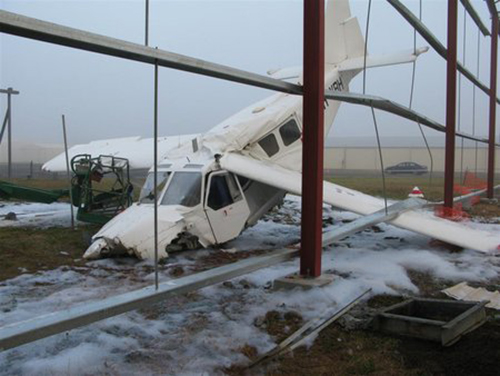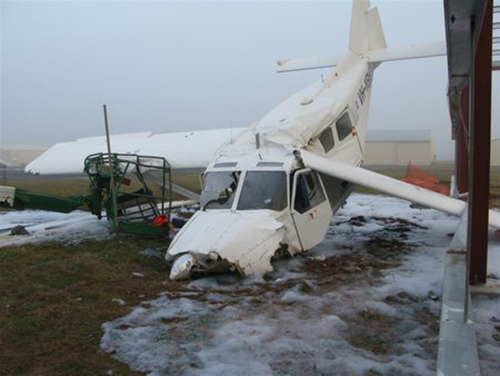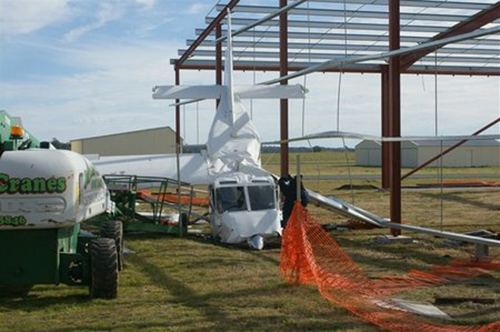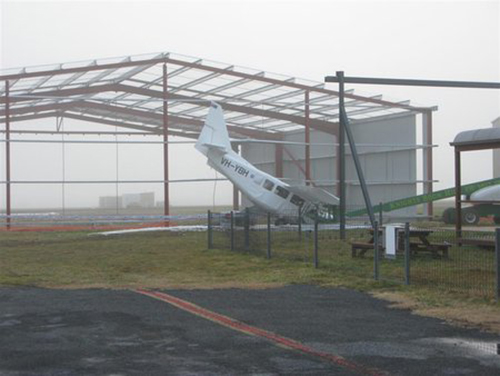Country
Crash of a Gippsland GA-8 Airvan in Orange
Date & Time:
Jul 6, 2010 at 1745 LT
Registration:
VH-YBH
Survivors:
Yes
Schedule:
Parkes - Orange
MSN:
GA8-08-131
YOM:
2008
Crew on board:
1
Crew fatalities:
Pax on board:
0
Pax fatalities:
Other fatalities:
Total fatalities:
0
Circumstances:
The pilot was performing a cargo flight from Parkes to Orange, New South Wales. On final approach, the single engine aircraft was too low and impacted the roof of a metal hangar located near the runway threshold. The aircraft stalled and struck the runway surface. Upon impact, the nose gear was torn off. Out of control, the aircraft veered off runway and eventually collided with a metal hangar under construction. While the pilot was injured, the aircraft was destroyed.







Crash of a Gippsland GA8 Airvan in the Buckingham Bay: 1 killed
Date & Time:
Oct 16, 2008 at 0945 LT
Registration:
VH-WRT
Survivors:
No
Schedule:
Elcho Island – Mata Mata – Muthamul –Nyinyikay – Rurruwuy – Elcho Island
MSN:
GA8-01-005
YOM:
2001
Crew on board:
1
Crew fatalities:
Pax on board:
0
Pax fatalities:
Other fatalities:
Total fatalities:
1
Captain / Total hours on type:
300.00
Aircraft flight hours:
4750
Circumstances:
On the morning of 16 October 2008, a Gippsland Aeronautics GA8 Airvan, registered VH-WRT, was being operated on a freight charter flight from Elcho Island and return, Northern Territory. At about 1230, it was realised that the aircraft was missing. A witness reported seeing the aircraft during the early stages of the flight and, shortly afterwards, a column of dark black smoke rising from the eastern side of the Napier Peninsula. On 17 October 2008, items of wreckage from the aircraft were found in the south-western part of Buckingham Bay. The pilot, who was the sole occupant of the aircraft, and the main wreckage of the aircraft have not been found. After consideration of the available evidence, the investigation was unable to identify any factor that contributed to the accident.
Probable cause:
Following a review of the available evidence covering:
• Witness information,
• The pilot's fatigue and health,
• The airworthiness of the aircraft,
• Aircraft fuel,
• The weather affecting the flight, and
• The aircraft’s loading and weight and balance,
The investigation was unable to identify any factors that may have contributed to the accident. From the evidence available, the following findings are made with respect to the missing aircraft at Buckingham Bay, Northern Territory on 16 October 2008 involving Gippsland Aeronautics GA8 Airvan aircraft, registered VH-WRT. They should not be read as apportioning blame or liability to any organisation or individual. No contributing safety factors were identified.
Other safety factors:
• The main vertical net and the throwover net were not used to restrain the cargo.
• The full jerry cans were not secured in the aircraft cabin.
• At the time of departure, the aircraft’s centre of gravity (c.g) was probably to the rear of the permitted c.g limit that was published in the Aircraft Flight Manual.
• There was no record that the pilot lodged a flight notification for the flight with Airservices Australia.
• Witness information,
• The pilot's fatigue and health,
• The airworthiness of the aircraft,
• Aircraft fuel,
• The weather affecting the flight, and
• The aircraft’s loading and weight and balance,
The investigation was unable to identify any factors that may have contributed to the accident. From the evidence available, the following findings are made with respect to the missing aircraft at Buckingham Bay, Northern Territory on 16 October 2008 involving Gippsland Aeronautics GA8 Airvan aircraft, registered VH-WRT. They should not be read as apportioning blame or liability to any organisation or individual. No contributing safety factors were identified.
Other safety factors:
• The main vertical net and the throwover net were not used to restrain the cargo.
• The full jerry cans were not secured in the aircraft cabin.
• At the time of departure, the aircraft’s centre of gravity (c.g) was probably to the rear of the permitted c.g limit that was published in the Aircraft Flight Manual.
• There was no record that the pilot lodged a flight notification for the flight with Airservices Australia.
Final Report:
Crash of a Gippsland GA8 Airvan in Cooinda
Date & Time:
Sep 9, 2008 at 1500 LT
Registration:
VH-KNE
Survivors:
Yes
Schedule:
Cooinda - Cooinda
MSN:
GA8-08-128
YOM:
2008
Crew on board:
1
Crew fatalities:
Pax on board:
0
Pax fatalities:
Other fatalities:
Total fatalities:
0
Circumstances:
The pilot was completing a local post maintenance test flight at Cooinda Airport. Shortly after takeoff, while in initial climb, the engine failed. The pilot attempted an emergency landing in the bush but the aircraft collided with a telephone pole and came to rest. The pilot escaped with minor injuries and the aircraft was damaged beyond repair.
Probable cause:
Engine failure for unknown reasons.
Crash of a Gippsland GA8 Airvan in Monteverde National Park: 1 killed
Date & Time:
Nov 2, 2006 at 0530 LT
Registration:
TI-BAH
Survivors:
No
Schedule:
San José – Liberia
MSN:
GA8-04-069
YOM:
2004
Crew on board:
1
Crew fatalities:
Pax on board:
0
Pax fatalities:
Other fatalities:
Total fatalities:
1
Circumstances:
The pilot, sole on board, departed San José-Alajuela-Juan Santamaria Airport at 0500LT on a positioning flight to Liberia-Daniel Oduber Quiros Airport located in the Guanacaste cordillera. About 30 minutes into the flight, the single engine aircraft crashed in unknown circumstances in the Monteverde National Park. The aircraft was destroyed and the pilot was killed.



Crash of a Gippsland GA8 Airvan in Latrobe Valley
Date & Time:
Feb 7, 1996 at 1845 LT
Registration:
VH-PTR
Survivors:
Yes
Schedule:
Latrobe Valley - Latrobe Valley
MSN:
GA8-0001
YOM:
1995
Crew on board:
1
Crew fatalities:
Pax on board:
0
Pax fatalities:
Other fatalities:
Total fatalities:
0
Captain / Total hours on type:
100.00
Circumstances:
The prototype GA-8 aircraft was undertaking test flying from the manufacturer's facility at the Latrobe Valley airfield. The test flying was scheduled by the designer under the provisions of a permit to fly approved by the Civil Aviation Safety Authority. For a series of spin tests the aircraft was fitted with fixed and jettisonable ballast, a jettisonable pilot's door, and a tail mounted anti-spin parachute attached to a long lanyard. On this flight the aircraft was set up at 9,000 feet above ground level with full power, flaps fully down, an extreme aft centre of gravity (C of G) and maximum all up weight. The test pilot, who was the only occupant, applied full left rudder and full right aileron to initiate a spin. After the aircraft entered a spin to the left the pilot applied standard control inputs to effect a recovery to normal flight. The aircraft did not respond and at 6,500 feet, 13 seconds after the spin commenced, the pilot jettisoned the ballast and deployed the anti-spin parachute. The aircraft still did not respond and at about 32 seconds into the spin, at 5,200 feet, the pilot initiated release of the jettisonable door, released his harness, baled out, and was clear of the aircraft as it passed through 3,600 feet. At 1,800 feet the aircraft was observed to stop spinning. Fifty seconds after the commencement of the spin, the aircraft dived into the ground and was destroyed. The pilot sustained minor injuries during his landing.
Probable cause:
This was a prototype aircraft and some deficiencies and/or problems during testing are to be expected. With this particular aircraft the fact that the inadequate rudder hinge moment was masked throughout flight testing meant that the inadequate rudder performance during critical spin recovery was not clearly detected until it combined with other factors to become critical. These other factors included an ineffective anti-spin parachute, extensive blanking of the fin and rudder, and flight at the extremes of the weight and C of G envelope. It is not known what , if any, effect the previous rerigging of the elevator controls had on this flight.
The following factors were reported:
1. The rudder and fin effectiveness was inadequate for the spin test being undertaken.
2. The anti-spin protection systems were ineffective.
3. The aircraft was not able to be recovered from an intentional spin.
The following factors were reported:
1. The rudder and fin effectiveness was inadequate for the spin test being undertaken.
2. The anti-spin protection systems were ineffective.
3. The aircraft was not able to be recovered from an intentional spin.
Final Report:



